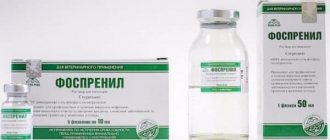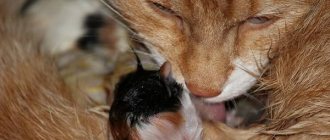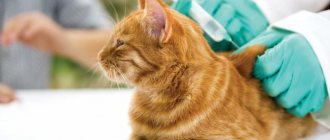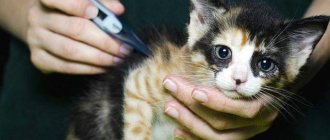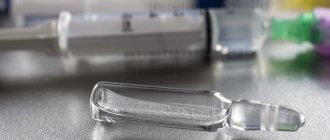Why does a cat limp after an injection?
Surely, each of you is familiar with the expression: “We treat one thing, and cripple another.”
This is exactly what many cat owners think when they are faced with the problem that the cat is limping after an injection. Sometimes this happens. Giving an injection can damage a cat's muscle or nerve. But such troubles do not always occur, because there are several causes of lameness and not all of them are caused by the ill-fated injection. So what should you do if your cat has lameness after injections in the thigh? In the case when this does not last long, about two or three days, then there is no need to worry. This kind of lameness can go away on its own. But if you notice that your cat has been limping severely for 14 days, dragging its paw, or cannot stand on it at all, then it is certainly time to show it to the veterinarian.
How to recognize a bruise or injury to the forelimb
An injury or bruise is fairly easy to spot. With such ailments, the animal cannot step on a limb. When trying to touch a sore spot, the cat will remove its paw.
Cat with an injured paw
Animals that are constantly in an active state often suffer bruises on their limbs. Main signs of damage:
- the limb at the site of the injury begins to swell;
- hematoma, which manifests itself even through the fur;
- there are no visible wounds on the injured paw;
- the paw is in its natural state;
- joints are movable;
- the injured area is slightly warmer to the touch than other areas of the body;
- the animal constantly licks the injured limb.
Cat with a bruised front paw
A fracture, unlike a bruise, should be taken much more seriously. Its signs are easier to identify, even without medical education:
- unnatural shape of the damaged paw;
- a broken bone can be easily felt;
- swelling forms on the paw.
Additional Information! Bruises and fractures are characterized by a sudden onset of lameness. Such injuries can result from a simple jump on a chair or windowsill.
In addition to injuries, some diseases also cause lameness.
Joint diseases
Joints may hurt due to calicivirus infection. The course of this disease was observed in detail in adult cats and kittens. And it has been proven that this cat cold often causes a virus to appear in the tissues of the joints, as a result of which the pet can begin to limp.
Infections
Mycoplasmosis and chlamydia in rare cases can cause lameness. In this case, the infection affects all the limbs of the animal, so it will limp on all limbs. Painful sensations appear due to infectious inflammation.
Chlamydia is often the cause of lameness
Bone tumor
Cancer, although rare, is a very dangerous disease. It is characterized by the appearance of multiple metastases throughout the animal’s body, which can result in lameness.
Arthritis and arthrosis
Arthritis is an inflammation of the joints that is common in older cats. This is an inflammatory disease that occurs as a result of pathological changes in the joints. With it, an animal at rest does not feel pain, but when walking and, especially running, the joints begin to ache. Arthritis can be identified by lack of appetite, weakness and elevated body temperature.
The main factors for its appearance:
- heredity;
- a sedentary lifestyle typical of neutered cats;
- improper diet;
- infections.
Additional Information! Poor environmental conditions may be among the causes of arthrosis. It has a negative impact not only on people, but also on animals.
Lameness after injection
Sometimes the injection may cause pain. This happens if the needle has hit a nerve, or if the medication you are taking has side effects. Usually the pain in the paw goes away after a few days.
The musculoskeletal system of cats, like that of people, works worse with age. As a result, the bones become brittle and the joints wear out. This is an extremely rare occurrence, but if lameness appears in an older cat, it is worth considering this cause.
Paw problems in older cats
Sometimes pain in a limb does not always mean that the problem lies there. As a result of injury to the lumbar back or brain, the animal may begin to limp. It is likely that a nerve may be pinched, causing the animal to experience discomfort when moving.
We suggest you read: Symptoms and signs of ear mites in cats. Let's talk about otodectosis
Lameness in the limbs can occur due to a lack of useful elements, especially calcium. It is unlikely that the animal will eat so poorly, however, this reason is typical for pregnant or lactating cats, because all the nutrients they receive go to feed the offspring.
The disease is typical for purebred cats. It appears at a young age and progresses over the years, resulting in the cat limping on one or both front legs.
Osteomyelitis
A disease characteristic of Persian cats. With it, partial destruction of bone tissue occurs. This disease is common in young animals and can affect any limb.
Causes of lameness
There are several reasons that cause lameness in a cat. The most basic of them include :
- Incorrectly given injection . Often, unscrupulous doctors or even frivolous and risky owners themselves who decide to inject the animal themselves, when administering the injection, can get into the muscle incorrectly and thereby injure it. There are also cases where a cat, after an injection, limped for a month and dragged its hind paw behind it. And this all happened because an inexperienced veterinarian hit the pet in the sciatic nerve.
- The use of Drotaverine , a drug that is best known to us as no-spa. It is not always suitable for cats. Those with mustaches will prefer Papaverine. If you give an injection of no-shpa, you can provoke the appearance of such a problem as paresis in the animal. It won't go away on its own. In addition, with paresis, other symptoms may appear on the first day: shortness of breath, muscle spasms and excessive salivation. If you observe such a clinical picture, then, of course, you need to tell a specialist about it.
In addition, we should not forget that a cat may begin to limp after an injection due to a simple coincidence. But in fact, the cause of lameness is other problems that are provoked by :
- A cut in the area of the paw pad.
- A spinal injury that could have occurred due to a blow or fight with a dog.
- Lack of microelements. We are talking in particular about calcium, a deficiency of which causes dystrophic changes in the joints.
- Infection. Mycoplasmosis or chlamydia affects the joints, causing inflammation in them, and the cat begins to limp.
- Age-related changes that lead to the appearance of arthritis and arthrosis.
- Fracture or dislocation of the paw. Especially if your cat is obese, then when jumping from the sofa, she could push off unsuccessfully or land on her paw and dislocate it.
- Cancerous tumor of the bone.
As you can see, there can be a lot of reasons for the appearance of lameness, so it is better to show the cat to a specialist who will conduct an examination and establish the true origin of such trouble.
What should the owner do?
Having noticed an uncertain, shaky gait in a furry beauty, the owner must take measures to identify the factors that led to lameness.
First of all, it is necessary to examine the sore paw for the presence of foreign bodies in it: splinters, splinters, glass, etc. If a cat is limping on a front paw, it is necessary to examine and feel the soft tissues of the limb to find out if there are ingrown nails that are interfering with the normal movement of the animal. If overgrown claws are detected, trimming them at home will return the pet to a normal gait.
After examining the paw pads, the injured limb should be carefully examined. Wounds and open fractures are easy to notice during visual inspection. In the absence of visible damage, you should feel the joints of the affected limb for swelling, swelling, pain, and increased local temperature.
If a cat has a sore paw, is limping and has dragging limbs, viral calcivirus should be ruled out. With this disease, in addition to gait disturbances, nasal discharge, sneezing, and conjunctivitis are observed. You should not diagnose your pet on your own. Only a veterinarian can determine that lameness is caused by a viral infection based on laboratory tests.
If the problem is not related to a splinter, wound, or visible damage, the owner should take the limping cat to a specialized facility. The most reliable method for diagnosing hidden injuries of joints and bones is x-ray examination.
Using an x-ray, a veterinarian will see displacement of bones during a fracture, dislocations, ruptures of ligaments, disruption of the normal configuration in the joint, phenomena of hip dysplasia and other pathologies of the musculoskeletal system. This method is painless and can be performed in some cases without anesthesia, with light sedation of the animal.
Having noticed an uncertain, shaky gait in a furry beauty, the owner should
take measures to identify the factors leading to lameness. First of all, it is necessary to examine the sore paw for the presence of foreign bodies in it: splinters, splinters, glass, etc.
READ Why the chicken is limping and how to help it
Which ones are needed?
Some people believe that if a cat does not walk outside, then vaccinations are not necessary. But that's not true. An infectious disease that is dangerous for animals can be brought home on shoes. If the animal is accustomed to walking, then it is necessary to carry out a complex of vaccinations. Mandatory vaccinations include distemper, rabies, feline herpes and calcivirus. At the owner's request, the cat is vaccinated against chlamydia.
The first vaccination of a kitten is carried out at the age of 8-10 weeks against rhinotracheitis, calcivirus, panleukopenia. Revaccination - after 3-4 weeks. Rabies vaccinations are given no earlier than 12 weeks and repeated annually. It is recommended to use the vaccine from the same manufacturer each time. Especially if the cat tolerates it well. Quarantine after vaccination lasts 10-14 days, it is during this period that immunity to the disease is developed. It is necessary to limit the kitten from being outside and from contact with other animals, especially unvaccinated ones.
The role of feline calicivirus infection in the development of lameness syndrome.
So, calicivirus is undoubtedly capable of causing temporary polyarthritis (inflammation affecting more than one joint) in cats, more often in small kittens. This is a fairly common manifestation of calicivirus infection, and sometimes lameness syndrome can be associated with vaccinations (especially live vaccines).
The severity of the syndrome varies widely, from subtle inflammation and slight limping to severe polyarthritis, where cats refuse to move, lose their appetite, and exhibit painful reactions when touched.
Affected cats gradually recover on their own, but if clinical symptoms are severe, anti-inflammatory drugs may be used for treatment. In addition, many other diseases can cause lameness besides calicivirus infection, and if the clinical signs are severe or persist for more than five days, you should definitely consult a veterinarian.
Why is vaccination necessary?
It is important to have regular vaccinations for the following reasons:
If an animal is not vaccinated against rabies, then when it becomes ill, it becomes potentially dangerous to everyone.
- The diseases against which vaccines are created are deadly for animals. If an unvaccinated cat gets sick, then there is a high chance that everything will end in death.
- A sick cat poses a danger to other pets.
- Some diseases, such as rabies, are dangerous to humans. A cat can infect its owner. This disease is fatal to any living creature.
Return to contents
Dangerous consequences
Allergy to vaccine
If the animal is allergic, the injection is administered under the influence of an antihistamine. If there was no allergy to the first vaccination, this does not mean that it will not happen again. The substance can accumulate and cause complications in the cat after vaccination. Can be light or heavy. It manifests itself in the form of rashes, itching, swelling of the mucous membranes, and in severe cases - of the respiratory tract and internal organs. Rarely - anaphylactic shock. Requires immediate medical attention. There may also be hair loss, loose stools, vomiting, altered behavior, and the cat becomes lethargic.
Complications after injections in veterinary practice (part 1). Infiltrates, abscesses, phlegmons...
The topic of post-injection complications, as a rule, is not raised in a professional environment.
Why?
It’s just that for those who take this topic seriously, everything is already clear, and those who work according to the principle “it will do!” don’t “bother” with such “little things.”
The invention of disposable syringes significantly reduced the number of complications after injections associated with violations of asepsis and antisepsis, which somewhat dulled the vigilance of doctors
But... There is a growing (and, alas, not the first) new generation of doctors, both veterinary and, alas, humanities, who are not accustomed to carefully reading thick books, moreover, not intended specifically “for doctors.” After all, the technique of performing injections is the lot of middle staff; doctors have no business dealing with such “nonsense”; they have to think about what to do with the patient...
In addition, animal owners who learn to inject their pets on their own are also not always aware of the intricacies of this procedure, and there is no one to teach them.
Increasingly, post-injection complications are becoming a significant problem, especially for cat owners, and this is often due to a violation of the drug administration technique.
What complications after injections are most common?
Here is a list of the complications that occurred in my and my colleagues’ veterinary practice:
- Infiltration at the injection site
- Post-injection sarcoma of cats
- Abscess/cellulitis at the injection site
- Necrosis of surrounding tissues
- Phlebitis
- Paraphlebitis
- Allergic reaction at the injection site
- Pyrogenic reaction
- Systemic allergic reaction
- Air embolism of a vessel
- Fat embolism of a vessel
Below we will analyze each of the types of complications mentioned in this list. But, first, we recommend that you study the general rules for administering medications, compliance with which significantly reduces the likelihood of any post-injection complications.
What complications are caused by violating the rules of drug administration?
- When the rules of asepsis and antisepsis are violated, the following complications are most often observed: inflammatory infiltrate at the injection site, abscess and phlebitis.
- When irritating substances enter loose connective tissue: inflammatory infiltrate, sterile abscess/phlegmon, paraphlebitis or tissue necrosis, as well as post-injection soft tissue sarcoma (especially in cats).
- When cold substances get into the tissue (especially when using biological products, oil solutions and suspensions): infiltrates and post-injection sarcoma of soft tissues (especially in cats).
- If the technique for removing the needle is violated when irritating substances are introduced and these substances enter the thickness of the skin: necrosis of the skin around the injection channel, inflammatory infiltrate.
- When using expired or low-quality drugs, as well as in the presence of individual sensitivity to the drug: an allergic reaction at the injection site or systemic, eosinophilic infiltrate or pyrogenic reaction.
- When using drugs not intended for intravascular administration or when the technique of intravascular administration of drugs is violated: phlebitis, paraphlebitis, air or fat embolism of blood vessels.
Thus, if a specialist performing injections experiences a large number of post-injection complications, it is urgent to analyze the injection technique to identify the source of the complications.
Infiltration at the injection site
Infiltration at the injection site can occur as a result of a variety of reasons.
- If the administered substance has irritating properties (hypertonic solution, excessive acidity or alkalinity of the reaction, etc.), then an inflammatory reaction occurs in response to the introduction of such a substance.
- If, during the introduction of a medicinal substance, microorganisms enter the injection zone, then an inflammatory process occurs as a response to their introduction.
- If an allergic reaction occurs when a drug is administered, one of its components is an inflammatory reaction at the injection site.
The inflammatory reaction is manifested by increased blood circulation in the area of drug administration, effusion of the liquid part of the blood - serous exudate, and the release of immune defense cells from the blood vessels: neutrophil leukocytes, eosinophils, lymphocytes.
In a normal situation, even if a slight inflammatory reaction to the administration of a drug is present, this is accompanied by the effusion of serous exudate and the release of a small number of cells. This effusion dilutes the administered drug, and increased blood circulation at the site of the reaction promotes rapid absorption of the contents of the infiltrate into the blood. This infiltrate is called serous and quickly resolves.
Infiltration - tissue compaction, often painful, at the injection site - is a sign of an inflammatory reaction at the site of drug administration.
But it happens that the inflammatory reaction to the administration of the drug does not go as it should. The stage of effusion of serous exudate and a strong increase in blood circulation is reduced, and inflammatory cells come out in greater numbers and for longer than during a normal inflammatory reaction.
- This happens, for example, when the body's reactions are weakened or distorted as a result of illness or stress.
- This happens when you inject a cold drug. As a result of the administration of a cold drug, reactive vasospasm occurs and rapid resorption of the injected drug does not occur.
- This happens when the dose of an oil-based drug or in the form of a suspension administered into one place exceeds the tissue’s ability to quickly absorb this drug.
- This happens when severe irritation from the injected drug causes the death of surrounding cells and disruption of blood circulation in the injection area.
The most severe inflammatory reaction is observed when a substance intended for intramuscular or intravenous administration enters loose connective tissue (subcutaneous, perivascular or intermuscular fatty tissue). An abundant capillary network, large spaces between cells and many elements of connective tissue create opportunities for the rapid development of an inflammatory response.
But if the body’s reactions are weakened, then a significant increase in blood circulation does not occur, and the release of leukocyte cells can be prolonged for a long time. And after the leukocytes in the area of the inflammatory infiltrate, connective tissue cells begin to multiply vigorously, leaving a compaction in the area of the inflammatory reaction for a long time.
Signs of aseptic infiltrate:
- compaction at the injection site, which grows for 2-3 days, and then begins to gradually decrease and dissolve
- moderate pain in the area of compaction
- with intramuscular administration - a slight impairment of limb function (claudication), which gradually disappears
- body temperature is usually normal or slightly elevated,
- changes in appetite and thirst are usually not observed (except in particularly sensitive patients)
- there is no clear boundary between the compaction and surrounding tissues by the end of 4-5 days
The infiltrate remains for a long time when the force of irritation at the injection site exceeds the body’s ability to eliminate the consequences of the inflammatory reaction.
How to prevent the formation of infiltrates
Do not use drugs that have an irritating effect for subcutaneous administration. Use intramuscular administration (blood circulation in the muscles is stronger, and there are fewer connective tissue elements) or intravenous administration (if possible, and always in dilution) of such drugs.
Warm injected medications. This will reduce irritation of surrounding tissues, prevent spasm of capillaries and small vessels at the site of drug administration, and speed up the absorption of the injected drug.
How to deal with infiltration
If the infiltrate is not accompanied by itching and does not grow in size, then from 3-5 days after its formation, dry heat can be used to speed up its resorption. The easiest way to apply dry heat is to use sand or coarse salt. They can be heated in a frying pan or in the microwave and poured into a fabric bag or just a sock. This heating pad should be used for 15-20 minutes several times a day. Dry heat activates blood circulation and promotes rapid resorption of the infiltrate.
If the infiltrate area is itchy or the infiltrate itself continues to increase in size, heat should not be used!
In this case, it is worth taking a puncture from the area of infiltration for cytological analysis. Based on the results of this analysis, the necessary treatment will be recommended for the animal.
Abscess/cellulitis at the injection site
If the irritation is so strong that it causes the death of many cells at the site of drug administration or infectious agents are introduced into the injection area, then a purulent inflammatory process develops in response to this.
If this process is limited to a strong demarcation line of neutrophils and histiocytes and does not spread into the surrounding tissue, then an abscess forms. If the area of inflammation is limited only to the surrounding dense tissues (skin, fascia), then such inflammation is called phlegmon - diffuse purulent inflammation.
Signs of phlegmon and abscess at the injection site:
- increase in local and general temperature,
- increasing pain at the injection site and around it,
- increase and thickening of the swelling at the injection site in the first days, followed by softening in the center (abscess) or in several places (phlegmon),
- the animal may refuse to feed, an increase or sharp decrease in thirst, with phlegmon - signs of dehydration,
- if the injection is given intramuscularly, then the dog or cat tries not to use the affected limb,
- if the injection is subcutaneous, then there is often a “draining” of the purulent infiltrate below the injection site or its “spreading”.
In any case, purulent inflammation (abscess or phlegmon) is more painful and has greater systemic reactions than the aseptic infiltrate that we described above.
How to prevent abscess and cellulitis at the injection site
- Strictly follow the rules of asepsis and antiseptics. Wash your hands before preparing to administer medications.
- Do not use one syringe for sequential administration of several medications.
- Use sterile preparations, do not store open ampoules. If the medicine from one ampoule is planned to be divided into several injections, then the medicine should be immediately taken into several syringes and stored closed in the refrigerator.
- Keep the syringe needles in the cap until the moment of injection, do not touch the injection needles with your hands.
- For intramuscular and subcutaneous injections, it is not necessary to treat the injection site with an antiseptic, but it is very advisable to spread your hands or cut off the contaminated hair at the injection site. For intravenous, intraarterial and intraosseous injections, treatment of the injection site is mandatory.
How to treat purulent inflammation at the injection site
A doctor should carry out such treatment depending on the stage of purulent inflammation. In the initial stages, this may include novocaine blockades or other methods of physiotherapy; in later stages, this may involve opening and draining the purulent cavity.
To be continued…
Natalya Troshina, veterinarian (DVM)
What to do if complications occur?
If your cat has a reaction to vaccination, you need to take the following measures:
- If there is a lump or swelling at the injection site, doctors recommend massaging this area. Most often appears in the withers area. The same is done if the cat is limping.
- The lump turns into an abscess - antibiotics or surgery are prescribed to remove it.
- In case of nerve damage and paralysis, long-term therapy is carried out.
- If an allergic reaction occurs, you need to give your cat antihistamines. Anaphylaxis can manifest itself in the form of convulsions, loss of consciousness, and affects the gastrointestinal tract. If your pet feels sick or vomits, it may be a manifestation of an allergy. Urgent help from a veterinarian is needed with the administration of antihistamines and droppers to relieve intoxication.
- If the temperature rises, give an antipyretic.
If complications occur, you must inform your veterinarian.
Diagnosis of cat lameness
In any case, if you find problems with your paw, you should definitely see a doctor. At the appointment, the veterinarian will need to perform the following diagnostic steps:
- A survey of the cat's owner to determine how the animal was injured or the possibility of other symptoms.
- Visual inspection. The veterinarian determines the sore spot, possible external signs of lameness, and also looks at how the pet stands and moves.
- Neurological examination to exclude the possibility of damage to the nervous system and brain.
- X-ray. It will allow you to see the causes of lameness inside the limb.
Additionally, urine, stool and blood tests, ultrasound and MRI may be needed. The doctor begins to treat the animal if the cause of the pain in the paw is discovered.
Examination by a veterinarian
Prevention
To minimize the risk, you must adhere to certain rules. The vaccination must be done by a specialist in the clinic, so that the cat is under the supervision of a doctor for an hour. It is necessary to check the expiration date of the vaccine. Injections should be given when the animal is healthy and not wormed. Adhere to the vaccination and revaccination dates. After vaccination, do not bathe, do not wash the injection site, and do not overcool. Be sure to comply with quarantine. During teething in kittens and pregnancy in adult cats, it is better to abstain.
The owner should monitor the pet's condition in the first week. The cat stopped eating and drinking, vomited, a wound or other symptoms listed above appeared at the injection site; this must be reported to the veterinarian. Only he will decide whether to take measures for treatment. If a cat vomits, this may be a common individual symptom, or it may indicate the onset of anaphylactic shock.
Why does a cat limp?
Lameness in a cat can occur due to many reasons.
Lameness in a pet can be caused by many reasons that are invisible at first glance:
- wound between joints;
- dislocation;
- sprain;
- fracture;
- injury;
- pathology of joint formation;
- arthritis or arthrosis of the joints;
- lumbar back injury.

